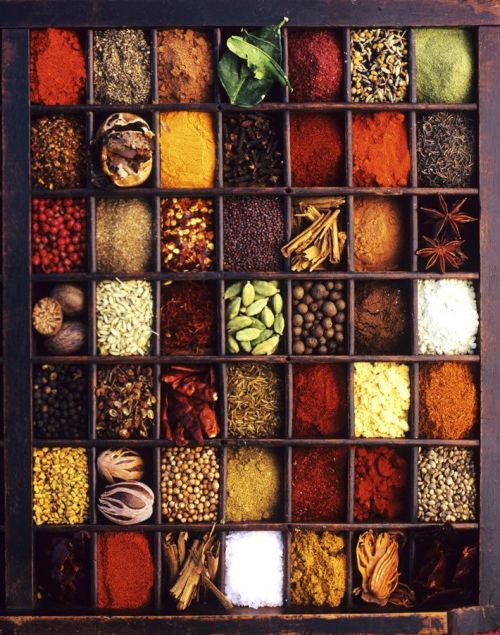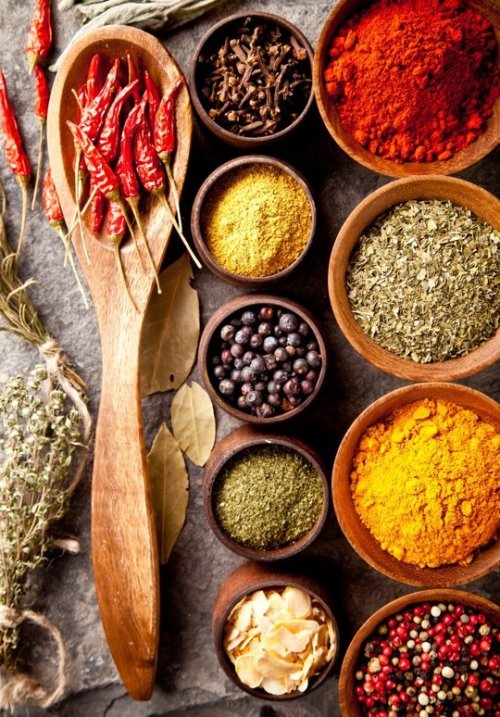

beautifulpicturesofhealthyfood:
Quick Guide to Every Herb and Spice in the Cupboard
Dried Herbs & Spices
- Asafoetida (Asafetida) - Used as a digestive aid in Indian cooking, asafoetida has a strong odor that mellows out into a garlic-onion flavor.
- Achiote Paste and Powder - Reddish-brown paste or powder ground from annatto seeds with an earthy flavor. Used primarily in Mexican dishes like mole sauce, cochinita pibil, and tamales.
- Allspice - Similar to cloves, but more pungent and deeply flavored. Best used in spice mixes.
- Annatto Seeds - A very tough reddish-brown seed with a woodsy aroma and an earthy flavor. Called Achiote Paste (see above) when ground, this is used to flavor many Mexican dishes.
- Bay Leaf - (also: Indian Bay Leaf) Adds a woodsy background note to soups and sauces.
- Caraway Seed - These anise-tasting seeds are essential for soda bread, sauerkraut, and potato salad.
- Cardamom - This warm, aromatic spice is widely used in Indian cuisine. It’s also great in baked goods when used in combination with spices like clove and cinnamon.
- Cayenne Pepper - Made from dried and ground red chili peppers. Adds a sweet heat to soups, braises, and spice mixes.
- Chia Seeds - No, these seeds aren’t just for growing crazy terracotta sculptures! Nearly flavorless, they can be ground into smoothies, cereals, and baked goods for extra nutrition and texture, or even used as a vegan egg substitute.
- Cinnamon - (also: Vietnamese Cassia Cinnamon) Found in almost every world cuisine, cinnamon serves double duty as spice in both sweet and savory dishes.
- Cloves - Sweet and warming spice. Used most often in baking, but also good with braised meat.
- Coriander Seed - Earthy, lemony flavor. Used in a lot of Mexican and Indian dishes.
- Cumin - Smoky and earthy. Used in a lot of Southwestern US and Mexican cuisine, as well as North African, Middle Eastern, and Indian.
- Fennel Seed - Lightly sweet and licorice flavored. It’s excellent with meat dishes, or even chewed on its own as a breath freshener and digestion aid!
- Fenugreek - Although this herb smells like maple syrup while cooking, it has a rather bitter, burnt sugar flavor. Found in a lot of Indian and Middle Eastern dishes.
- Garlic Powder - Garlic powder is made from dehydrated garlic cloves and can be used to give dishes a sweeter, softer garlic flavor.
- Ginger - Ground ginger is made from dehydrated fresh ginger and has a spicy, zesty bite.
- Gochugaru - This Korean red pepper spice is hot, sweet, and ever-so-slightly smoky.
- Grains of Paradise - These taste like a cross between cardamom, citrus, and black pepper. They add a warming note to many North African dishes.
- Kaffir Lime Leaves - Used to flavor curries and many Thai dishes. Can be sold fresh, dry or frozen.
- Loomi - Also called black lime, this is ground from dried limes. Adds a sour kick to many Middle Eastern dishes.
- Mace - From the same plant as nutmeg, but tastes more subtle and delicate. Great in savory dishes, especially stews and homemade sausages.
- Mahlab - Ground from sour cherry pits, this spice has a nutty and somewhat sour flavor. It’s used in a lot of sweet breads throughout the Middle East.
- Nutmeg - Sweet and pungent. Great in baked goods, but also adds a warm note to savory dishes.
- Nutritional Yeast - Very different from bread yeast, this can be sprinkled onto or into sauces, pastas, and other dishes to add a nutty, cheesy, savory flavor.
- Oregano - Robust, somewhat lemony flavor. Used in a lot of Mexican and Mediterranean dishes.
- Paprika - Adds a sweet note and a red color. Used in stews and spice blends. There is also a spicy version labeled hot paprika.
- Peppercorns - Peppercorns come in a variety of colors: black, white, pink, and green being the most popular, these are pungent and pack a mild heat.
- Rosemary - Strong and piney. Great with eggs, beans, and potatoes, as well as grilled meats.
- Saffron - Saffron has a subtle but distinct floral flavor and aroma, and it also gives foods a bright yellow color.
- Sage - Pine-like flavor, with more lemony and eucalyptus notes than rosemary. Found in a lot of northern Italian cooking.
- Smoked Paprika - Adds sweet smokiness to dishes, as well as a red color.
- Star Anise - Whole star anise can be used to add a sweet licorice-y flavor sauces and soups.
- Sumac - Zingy and lemony, sumac is a Middle Eastern spice that’s great in marinades and spice rubs.
- Turmeric - Sometimes used more for its yellow color than its flavor, turmeric has a mild woodsy flavor. Can be used in place of saffron in a pinch or for those of us on a budget.
- Thyme - Adds a pungent, woodsy flavor. Great as an all-purpose seasoning.
- Vietnamese Cassia Cinnamon - (also: Cinnamon) Sweet and spicy. Can be used in both sweet baked goods and to add depth to savory dishes.
Fresh Herbs
- Basil - (also: Thai Basil) Highly aromatic with a robust licorice flavor. Excellent in pestos, as a finishing touch on pasta dishes, or stuffed into sandwiches.
- Chervil - Delicate anise flavor. Great raw in salads or as a finishing garnish.
- Chives - Delicate onion flavor, great as a garnish.
- Cilantro - From the coriander plant, cilantro leaves and stems have a pungent, herbaceous flavor. Used in Caribbean, Latin American, and Asian cooking.
- Curry Leaves - These pungent leaves are not related to curry powder but impart a similar flavor. Used in Indian, Malaysian, Sri Lankan, Singaporean, and Pakistani cuisine. Used to flavor curries, soups, stews, and chutneys.
- Dill - Light and feathery herb with a pungent herb flavor. Use it for pickling, with fish, and over potatoes.
- Fenugreek - Although this herb smells like maple syrup while cooking, it has a rather bitter, burnt sugar flavor. Found in a lot of Indian and Middle Eastern dishes.
- Lemon Thyme - (also: Thyme) Sweet lemon aroma and a fresh lemony-herbal flavor. This is excellent with poultry and in vinaigrettes.
- Lovage - Tastes like a cross between celery and parsley. Great with seafood or to flavor stocks and soups.
- Marjoram - Floral and woodsy. Try it in sauces, vinaigrettes, and marinades.
- Mint - Surprisingly versatile for such an intensely flavored herb. Try it paired with lamb, peas, potatoes - and of course, with chocolate!
- Oregano - Robust, somewhat lemony flavor. Used in a lot of Mexican and Mediterranean dishes.
- Parsley - Available in flat-leaf (Italian) or curly varieties, this very popular herb is light and grassy in flavor.
- Pink Pepper - Small and sweet, these berries are fantastic when marinated with olives or simply sprinkled on shortbread.
- Rosemary - Strong and piney. Great with eggs, beans, and potatoes, as well as grilled meats.
- Sage - Pine-like flavor, with more lemony and eucalyptus notes than rosemary. Found in a lot of northern Italian cooking.
- Summer Savory - Peppery green flavor similar to thyme. Mostly used in roasted meat dishes and stuffing, but also goes well with beans.
- Shiso - A member of the mint family, this herb is used extensively in Japanese, Korean, and South East Asian cooking as a wrap for steaming fish and vegetables, in soups, and as a general seasoning.
- Tarragon - Strong anise flavor. Can be eaten raw in salads or used to flavor tomato dishes, chicken, seafood, or eggs.
- Thai Basil - (also: Basil) A spicy, edgier cousin to sweet Italian basil. A must-have for Thai stir-fries, Vietnamese pho, spring rolls, and other South Asian dishes.
- Thyme - (also: Lemon Thyme) Adds a pungent, woodsy flavor. Great as an all-purpose seasoning.
from Beautiful Pictures Of Healthy Food http://www.beautifulpicturesofhealthyfood.com/post/155696640099
from Tumblr http://0foodphotography.tumblr.com/post/155696947367
via IFTTT
No hay comentarios:
Publicar un comentario